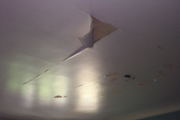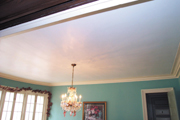

At what point do you decide to give a new product a try? For myself, trying some new products is easier to swallow than others. If a supplier I trust recommends something, I'll usually give it a try. When the big names in the industry come out with new products, some are failures but for most new products, it's usually a safe bet that some research has been done concerning product reliability.
What about products from those small companies that lack Fortune 500 marketing resources but are offering a product that appears to be what you're looking for? This is what I recently came up against with Specification Chemicals' Nu-Wal.
The difficulty with making a decision about using this product is its use is the end result of the work you are doing. Regardless of the quality of the work you have done, this product is all the customer is going to see when the job is complete. This is what the customer is going to remember about you and defines how the customer is going to speak about you with others in the future. Another challenge I had with Specification Chemicals is its sales and marketing plan. The products are available mail order only so there is no local supplier to rely on for experience and advice.
This old ceiling
I recently did a ceiling repair that involved removing failing canvas. Canvasing walls and ceilings was once a common remedy for failing plaster. Quoting the National Parks Service, Preservation Brief 21 on canvasing:"Uneven wall surfaces, caused by previous patching or by partial wallpaper removal, are common in old houses. As long as the plaster is generally sound, cosmetically unattractive plaster walls can be 'wallpapered' with strips of a canvas or fabric-like material. Historically, canvasing covered imperfections in the plaster and provided a stable base for decorative painting or wallpaper."
Translated to common industry terms, this means that canvasing feathers, balances, smoothes out, covers, hides, etc., the visual effects of the surface repair. Stable base speaks for itself, canvas ties back together wall surfaces that have functionally become multiple wall surfaces.
The use of Nu-Wal is straight-forward. An acrylic base is first brushed and rolled onto the surface to be covered. This is followed by applying the fiberglass fabric much like wallpaper is hung. Seams are overlapped by about an inch and then cut with razor blade, utility knife, olfa knife, etc. There is no cut line provided in the fabric that I would have liked to have had. It would have helped with the cutting while working overhead off a stage. Unlike wallpaper, a brush is not used for leveling and embedding. Once applied, the fabric is rolled with a damp paint roller for embedding. Walls can easily be done by one person. A ceiling, depending on size, will take two or more.
One advantage to canvas that is not offered with Nu-Wal is the ability to choose canvas by weight. Depending on the amount and extent of damage and repairs, a plasterer could determine which canvas to use. The benefit here is that heavier canvases have less tendency to highlight repairs or damage by not "sucking" up to the contour of the covered surface. I would like to see Nu-Wal's fabric offered in various weights.
Another consideration for some might be the fabric cut line does leave a noticeable seam if you are looking for one. This may have been the result of my lack of familiarity with the product. Regardless, for my use of Nu-Wal this is not historically inaccurate. New canvas also has a noticeable seam. With canvas, subsequent years of repainting would cover and hide the seam. Specification Chemicals does suggest filling the seam with a small amount of joint compound applied with fingers if the user does prefer to eliminate the seam.


Report Abusive Comment